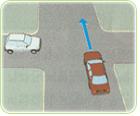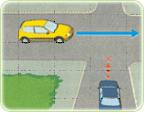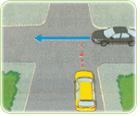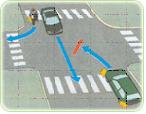- The driver of a motor vehicle which is about to enter an intersection without traffic control shall give way to another vehicle which has already entered the intersection (Article 26(1) of the Road Traffic Act).

- The driver of a motor vehicle which is about to enter an intersection without traffic control shall slow down, provided that the width of the road on which he/she is driving is narrower than that of the intersecting road. The driver shall also give way to any other vehicle which is about to enter the intersection from the wider road (Article 26(2) of the Road Traffic Act).

- The driver of a motor vehicle which is about to enter an intersection without traffic control at the same time as another vehicle which is about enter from the road on the right-hand side shall give way to that vehicle (Article 26(3) of the Road Traffic Act).

- The driver of a motor vehicle which is about to turn left at an intersection without traffic control shall give way to another vehicle which is about to go straight or turn right (Article 26(4) of the Road Traffic Act).

|
Violation |
Penalty(KRW) |
|
Violation of obligation to give way at an intersection |
Vans: 50,000 Cars: 40,000 Two-wheeled vehicles: 30,000 Bicycles: 20,000 |
- All drivers of motor vehicles(except emergency vehicles) wishing to drive their vehicle more slowly than those travelling behind his/her vehicle shall give way to them by driving his/her vehicle along the right-hand edge of the road (Article 20(1) of the Road Traffic Act).
· The above provision shall not apply to roads with four or more lanes, provided that a motor vehicle travelling behind another motor vehicle can overtake it in the proper way (Article 20(1) of the Road Traffic Act).
※ ‘Emergency vehicle’ includes the vehicles listed in the following box. It refers to vehicles that are used for their intended emergency purpose. The vehicles listed from 9 to 12 are emergency vehicles only when they are designated as such by the Commissioner of a Local Police Agency after the application of the user or organization concerned (Article 2(22) of the Road Traffic Act, Article 2(1) of the Enforcement Decree of the Road Traffic Act).
1. Fire engines.
2. Ambulances.
3. Blood supply vehicles.
4. Motor vehicles operated by the police for criminal investigation, traffic regulation, or any other emergency police operations.
5. Motor vehicles operated by the national armed forces and the United Nations Forces in Korea for maintaining order within the armed forces or for ensuring the orderly movement of military troops in convoys.
6. Motor vehicles operated by investigative agencies for criminal investigations.
7. Motor vehicles operated by facilities or agencies falling under any of the following categories when transporting arrested runaways or carrying and guarding inmates or probationers:
(a) Correctional institutions, juvenile detention homes, detention houses, and protective custodial houses;
(b) Juvenile reformatories and juvenile classification and examination offices;
(c) Probation offices.
8. Motor vehicles used by official security services for domestic and foreign key figures.
9. Motor vehicles used in emergency operations for hazard prevention by organizations and institutions that provide electricity, gas or any other public utilities services.
10. Motor vehicles mobilized for emergency preventive measures or restoration works by the government agency responsible for civil defense affairs.
11. Motor vehicles that are used in emergency works undertaken to prevent hazards on the road, operated for road maintenance purposes, and those controlling the vehicles operated under restrictions.
12. Motor vehicles used for emergency services such as repair works related to telegraph or telephone systems, for emergency postal delivery services including the transportation of mail, and for radio wave monitoring.
· In addition to the motor vehicles set forth above, those vehicles moved under a convoy of emergency police vehicles, those operated by the ROK Armed Forces and the United Nations Forces in Korea, or moved under a convoy of emergency vehicles of the ROK Armed Forces or the United Nations Forces in Korea, and those transporting a critical patient, an injured person or blood for a transfusion, shall be deemed to be emergency motor vehicles (Article 2(2) of the Enforcement Decree of the Road Traffic Act).
- Emergency motor vehicles may pass through the center or left-hand side of the road in the event of an emergency or due to other inevitable reasons. When any emergency motor vehicle is approaching the intersection or in the vicinity of the intersection, the drivers of motor vehicles and trams, and riders of horses shall pull away from the intersection to temporarily stop. When any emergency motor vehicle is approaching any other place, the drivers of motor vehicles and trams, and riders of horses shall yield the right of way to the emergency motor vehicle. (Article 29(1), (4), and (5) of the Road Traffic Act).
- When motor vehicles (other than emergency motor vehicles) are travelling in opposite directions on a narrow road, one or other of the motor vehicles concerned shall yield by moving to the right-hand side of the road according to the following classification (Article 20(2) of the Road Traffic Act).
· Where motor vehicles are travelling in opposite directions on a sloping narrow road, the motor vehicle travelling uphill shall yield.
· Where a motor vehicle carrying a person or loaded goods and an empty motor vehicle are travelling in opposite directions on a narrow road other than a sloping narrow road, the empty motor vehicle shall yield.